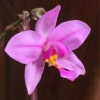|
|
|
|
|
| |
Established Seedlings of
Spathoglottis plicata 'MC6236' -spontaneous |
|
| |
|
|
| |
| Number: |
TN7481 |
| Name: |
Spathoglottis plicata 'MC6236' -spontaneous
|
| Type: |
spontaneous (What's that?) |
|
Seed Donor: |
Martin L. Buote
|
|
Click to Enlarge

Offspring 'MC7401' Flower |
| Offspring photos are siblings of the plants you would receive. |
|
|
|
| |
Comments: Parent plant: One of the offspring from our TN1075 effort of 1999, grown by Martin L. Buote.
For additional origin/habitat information supplied courtesy of
Charles and Margaret Baker, see further below, near the bottom of this page.
|
Temperatures we attempt to use in the lab & greenhouse:
| For Species: |
|
Spring, Summer, Autumn, Winter: days average 80°F, nights 68°F; best fit is Warm-Intermediate 87-64°F
(Source:
Baker's Web OSC) |
|
About the name...
| Etymology of |
plicata |
|
From Latin "plicatus" folded.
(Source:
Mayr & Schmucker 1998) |
| Etymology of |
Spathoglottis |
|
From latinized Greek "spatha" flower sheath; "glottis" tongue. The relation is unclear.
(Source:
Mayr & Schmucker 1998) |
| Pronunciation of |
plicata |
|
ply-KAH-ta
(Source:
Hawkes 1978) |
| Pronunciation of |
Spathoglottis |
|
spath-oh-GLOT-is
(Source:
Hawkes 1978) |
|
If you would like to direct someone to this web page, please copy and paste this URL into your email:
http://troymeyers.com/d?127481
|
ESTABLISHED SEEDLINGS
of these are not currently available, but we have some maturing in the greenhouse and expect to offer them in the future.
There is 1 item with
1 plant per
item that will be considered for sale later.
Click here to see if we have flasks available.
|
|
|
| |
The origin/habitat information below is supplied courtesy of Charles and Margaret Baker
The following information is based on the name of the plant provided by the donor, and assumes that the name is correct. If the plant has been misidentified, then the following information may not be correct.
This text is copyrighted by the Bakers and may not be reproduced without permission.
ORIGIN/HABITAT: Widespread from India through Southeast Asia. the
Philippines, Borneo, Peninsular Malaysia, Indonesia to New Guinea,
Australia, and the Pacific Islands. This orchid is found throughout the
Philippines where it grows as a terrestrial at up to 4900 ft. (1500 m),
usually in full sun. In Malaya, the species is common throughout the
country from Singapore in the south to Terengganu in the northeast at
elevations up to 2300 ft. 700 m). In Sumatra, plants are common and grown
in poor grassland areas in almost every province, usually in the foothills
below 2500 ft. (760 m). Plants are found all over Java from near sea level
to as high as 5250 ft. (1600 m). Comber (1990), however, reported that
most are found in the lower foothills at about 1950 ft. (600 m) in
grassland or on banks wherever competition from coarse vegetation is not
too severe. Plants in New Guinea have been reported from Manus Province,
an island off the northern coast of New Guinea, at 150-350 ft. (50-100 m).
In Australia this orchid is found in northeastern Queensland from the
Jardine River to Cooktown. It occurs in lowland regions near the coast
where it grows in or near swamps, or in low-lying areas which are
seasonally inundated, or in moist, grassy patches close to small streams.
More about this information and the Bakers...
|
|
|
| |
|
|
|